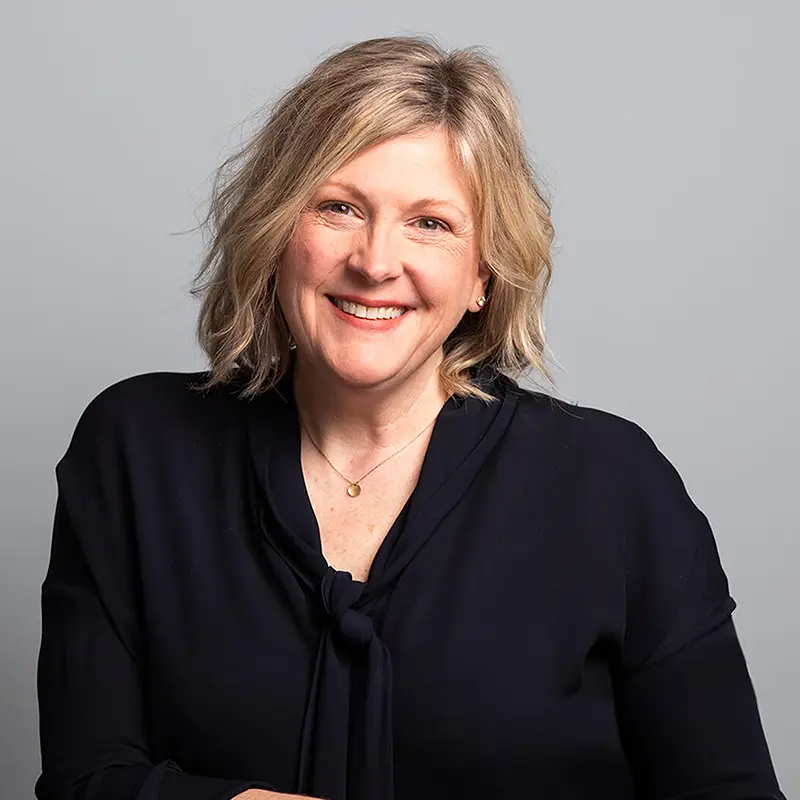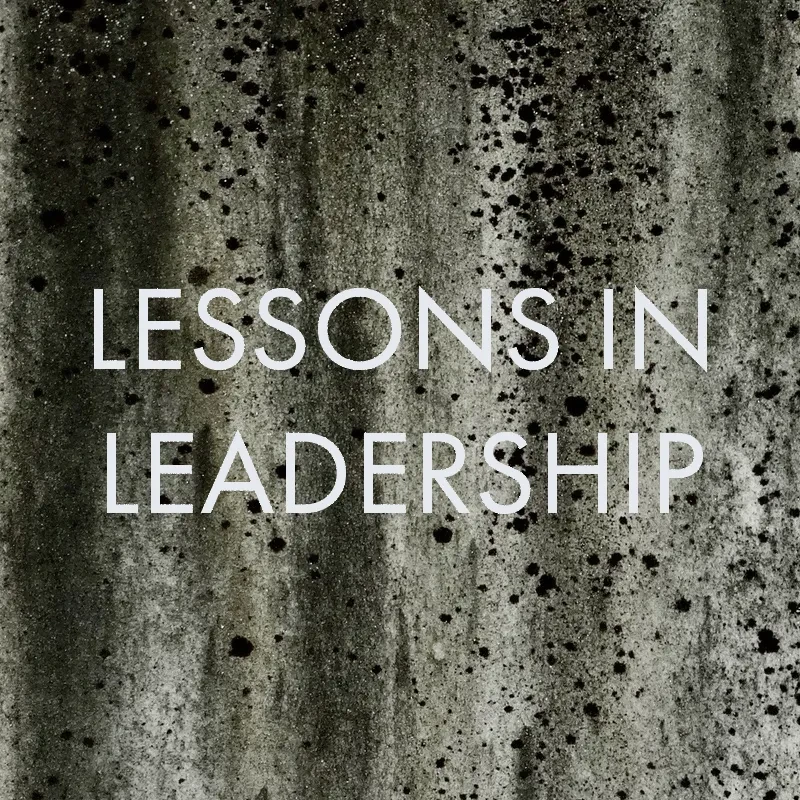
LEADING LINES
Erika Moody, FIIDA
President of Helix Architecture + Design
September 11, 2024
Erika Moody discusses leadership responsibilities, discipline convergence and the future.
DesignIntelligence/Michael LeFevre (DI): We’re talking with Erika Moody, FIIDA, president of Helix Architecture + Design and 2024-25 president of the International Interior Design Association (IIDA). Welcome Erika. Can you please offer a firm overview for the uninitiated?
Erika Moody (EM): Founded in Kansas City, Missouri, in 1992, Helix Architecture + Design’s mission is to create beautiful, humanistic design solutions that are responsible to client, community, environment, budget and our own high standards. Our work with visionary clients has contributed to the ongoing multibillion-dollar revitalization of downtown Kansas City, where we have led more than 60 projects, many combining LEED-certification criteria with federal and state historic tax credits to revive existing buildings. Helix’s diverse experience includes mixed-use, multifamily, workplace, academic, public libraries, civic, hospitality and cultural facilities, as well as specialized expertise with renovation, adaptive reuse and preservation of historic buildings.
We’ve been recognized with more than 225 regional, national and international awards for design excellence and thought leadership. I became president in 2021, and in 2023, Helix became a majority-woman-owned firm.
RESPONSIBILITIES
DI: The responsibilities of design firm leaders are greater than ever. Now, we are not only responsible for design and client service, but also to wrap our arms around social, environmental, diversity and economic aspects inside and outside our firms. Within Helix, how are you approaching a redefinition of this ever-broadening scope?
EM: Within the community, we strive to make better places to live and work. This is realized by the breadth of typologies in our portfolio, and even more so in how we create these places. For instance, our multifamily housing projects are responsive to the urban context and the needs of the communities. We’ve directed the renewal of more than 30 public libraries, transforming them into community centers that fulfill pressing needs in addition to providing the traditional scope of neighborhood libraries. In a time when our region was seeing a shortage of health care professionals, we approached the design of an award-winning university medical education and health sciences building with the intention of attracting students who would later work in the area.
A continuing hallmark of Helix’s sustainability practice is a dedication to adaptive reuse. It’s the ultimate way to recycle a building. We’ve extended several older buildings’ serviceable lives by modernizing them for viability in the current market. We’ve retrofitted legacy university buildings with high-tech medical simulation components and are actively adapting abandoned and underutilized office buildings into multifamily housing. Furthermore, we apply our principles to ourselves — both our old and new offices are adaptive-reuse projects. We moved into the new office ecologically as well, making sure that 100% of furnishing, equipment, accessories and such were reused or donated. Thus, nothing made it to the landfill.
In addition to the diversity of our project types, diverse talents and skill sets within Helix are at the core of our next generation, as our current leadership recently took the baton from the firm’s founders. We are changing the culture, eschewing the traditional hierarchical architecture and design firm format by developing additional paths for our people to succeed and develop their careers. We want to give our staff the best working experience we can by putting them on interesting projects and offering opportunities to interface with clients and affiliates. We give them the space and tools to become better architects and designers.
Socially, we place a high priority on giving back to our communities, particularly in dedicating time to organizations we believe in. While we’re active in IIDA, AIA and NOMA, we encourage staff to get involved in local nonprofits and urbanism organizations, such as Big Brothers Big Sisters, Mid-America LGBTQ Chamber of Commerce, ULI and Commercial Real Estate Women (CREW). Helix partner Alissa Wehmueller, IIDA, and I are both graduates of the Kansas City Chamber’s Centurions leadership program. Alissa and I, as well as our third partner, Doug Stockman, AIA, sit on varied boards and committees, from professional and civic to philanthropic and educational. We encourage our younger staff members interested in leadership to participate in programs that would broaden their horizons and let them make connections that will sustain them throughout their careers.
The responsibility of leadership will always be assuring the firm is financially sound. We understand Helix is a business that serves clients and staff. However, we are not going to throw out our principles or ethics for a lucrative job.
We don’t spend time pondering what makes us different. We spend it figuring out what best serves our clients and community.
DISCIPLINE CONVERGENCE
DI: As a combined architecture and interiors firm, how do the two coalesce? What edge does that give your teams, especially when doing an architecture-only or interiors-only project? How do you — as an interior designer — bring a different viewpoint to running an architecture firm?
EM: With a firm name derived from human DNA, Helix Architecture + Design sees the two disciplines as intrinsically intertwined. Helix takes an integrated, people-centric, whole-building approach to projects. This may entail ancillary services, such as feasibility studies, master planning, signage and wayfinding design, and post-occupancy evaluation, among others. Our studios aren’t siloed into architecture and interiors. They’re arranged by project, so both overlapping disciplines work together simultaneously. We are Helix Architecture plus Design, which adds up to better projects.
I’ve always believed the best result for the client and the users of a space is to fully integrate the design process. We prefer doing both the architecture and interiors, of course, though that doesn’t always happen. If we’re doing interiors only, our viewpoint and understanding align with the existing architecture because architects will be on that team, and vice versa for architecture-only projects. We are great on our own and we play well with others.
ORGANIZATIONAL FUTURES
DI: To cope with a changing context what are your thoughts on new business forms, value propositions, offerings and/or organizational structures to cope — and prosper — into the future? What are the road signs and leading indicators pointing to?
EM: Just as we adapt older buildings to meet current market demands — converting empty office space into housing as a primary example — we’re constantly evolving our firm. We have an established local presence in many cities in Missouri and Kansas and recently opened an office in Denver, where we have several multifamily projects on the boards. We have our eyes on Salt Lake City as another emerging market.
Our job is also to bring solutions to markets that can use the help. For instance, designing efficient and desirable multifamily buildings can allow more units to be built and more people to find homes. As one example, our latest Kansas City project brings much-needed affordable housing to an abandoned office building shell. Using a young teacher’s salary as one monthly rent benchmark, we worked with our developer partner so the project would make sense with market-responsive rents starting at about $700. The original program called for 117 units, but we optimized the plan to accommodate 139 apartments — a win-win for client and community. The solution was to design micro-unit studios as small as 320 square feet and add community amenities, such as a commercial kitchen, lounge and coworking area, to offset the smaller apartment sizes.
We’re seeing increasing demand for shared amenities in workplace design as well. With smaller office footprints and free-address desking, our workplace clients are willing to allocate more of the budget for amenity-rich office spaces. As an example, for our new office, we have three of the nine suites in a building that comprises two 1930s historic Film Row film distribution centers, which Helix renovated. We share outdoor spaces as well as a break room, lobby, mother’s room and smaller conference rooms with the other creative tenants. We see this as a great opportunity to connect with the other business owners in the building, while using space more efficiently.
I want to see a future where designers are at the important tables in municipal government, education, sustainability and culture — making decisions on communities from the perspective of problem-solving and beauty.
FIRM DIFFERENTIATORS
DI: What is it that truly makes your organization unique in the minds of clients? How do you see that evolving?
EM: The firm integration, again, of interiors and architecture from the beginning is a differentiator. Interiors wasn’t an add-on, as it is in many architecture firms, where it is sometimes treated as a lesser discipline. It’s not at Helix. Two of the partners are interior designers, and we are firmly entrenched in the industry. I recently became 2024-2025 IIDA International Board president. Alissa Wehmueller was president of our local IIDA, and one of our interior designers is next in line.
From the client perspective, our work is not branded to our identity. Stylistically, the project won’t scream “Helix.” We want it to represent the client’s image and needs and be meshed with the context and environment. What makes it a Helix project — the consistency in our work — is that our projects are responsive to what they are, where they are and who they are for. Our design is rigorously well-detailed and intentional — we place intention before style. It’s largely that approach that makes the work beautiful, which is a requirement for us.
We don’t spend time pondering what makes us different. We spend it figuring out what best serves our clients and community.
CONTEXT
DI: How have COVID-19 and the increasing uncertainty in the world, along with their impacts on interior space, real estate and the predictable markets of the past, changed your thinking, your designs and your and your customers’ objectives?
EM: We often use a residential model to inform current office projects. If you can work well at your kitchen counter or grab your laptop in bed to write down a great idea, is there a way to somehow translate those settings into an office environment? Flexible workstations that accommodate different postures throughout the day and plentiful comfort amenities are only two examples to coax people back to the office.
What’s more, many people have better access to daylight when working at home. We see this as possibly the most important part of office design moving forward: Incorporating daylight — with its mental and physical benefits — into interior spaces is especially important in the Midwest. Access to outdoor areas and the ability to work outside — while the weather permits — is part of this approach.
BUSINESS, RELATIONSHIPS AND VALUE
DI: Where are the sources of increased value for design firms and your clients? Are you looking in unconventional places?
EM: We’re fortunate that 75% of our business comes from repeat customers. We prioritize maintaining those relationships through post-occupancy debriefs whenever possible, wrap parties, sharing project photography and regular check-ins with clients between projects.
Realizing we needed market diversity beyond our immediate region to grow, we targeted areas within a couple hours’ flight of our Kansas City home base. Denver continued to pop up and has an active multifamily development market we’re now working in. We decided to open the office there and continue to look at expanding west, where we think Helix will be a great partner for developers who share our values.
THE FUTURE
DI: Describe your mentality for survival and beyond. What does the road ahead look like?
EM: I want to see a future where designers are at the important tables in municipal government, education, sustainability and culture — making decisions on communities from the perspective of problem-solving and beauty.
Erika Moody, FIIDA, is the president of Helix Architecture + Design, a nationally recognized architecture and interior design firm with offices in Kansas City and Denver. Her perspective is marked with leadership and driven by her entrepreneurial spirit. After serving as a principal at a large, international firm, she started her own design studio, which later merged with Helix. In 2021, Erika was named the president of Helix. Under her leadership, Helix has amassed a strong portfolio of sophisticated projects and became a majority-woman-owned firm. In addition to her many varied commitments to the IIDA, including serving as the IIDA Mid-America Chapter president from 2014 to 2015, she was recognized with the 2017 IIDA MADA (Mid-America Design Awards) Vision Award and elevated to fellowship in 2022. Both achievements acknowledge an individual who exemplifies notable qualities in leadership, design and mentorship. In June 2024, Erika was inaugurated as the IIDA International Board president, becoming a stronger advocate for interior design and its invaluable role in shaping environments that inspire occupants and promote their well-being.






















